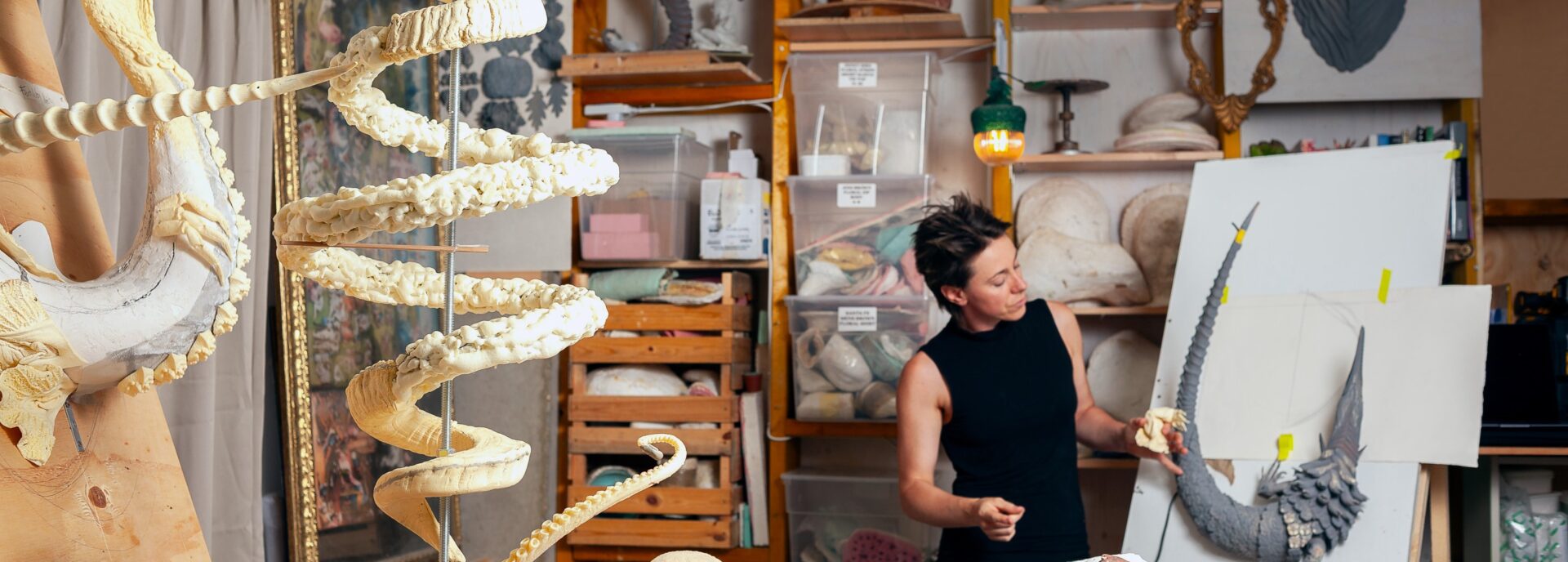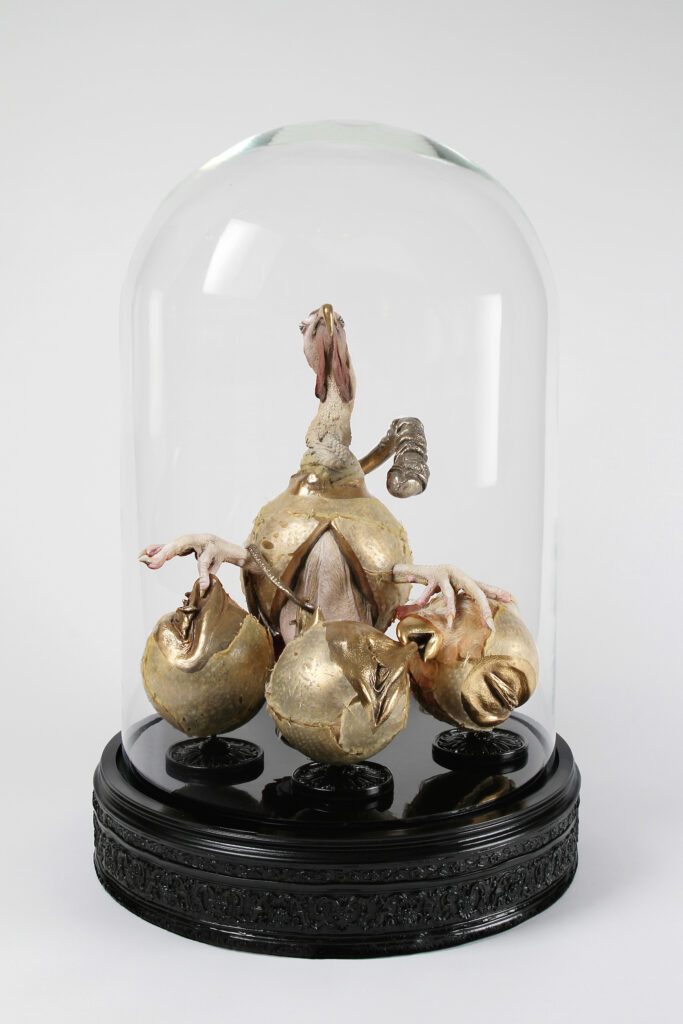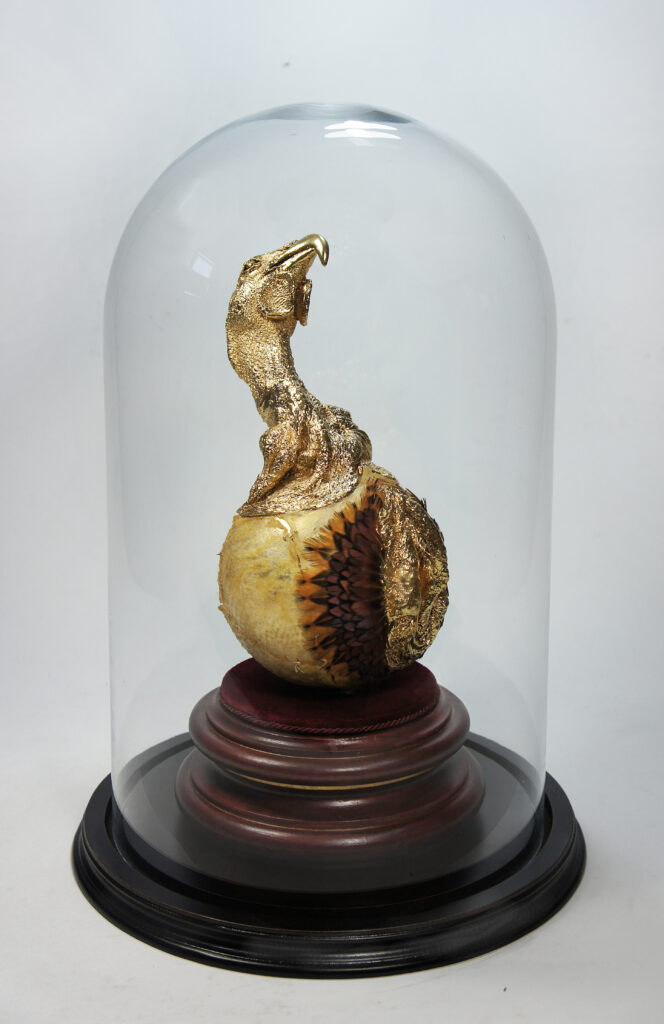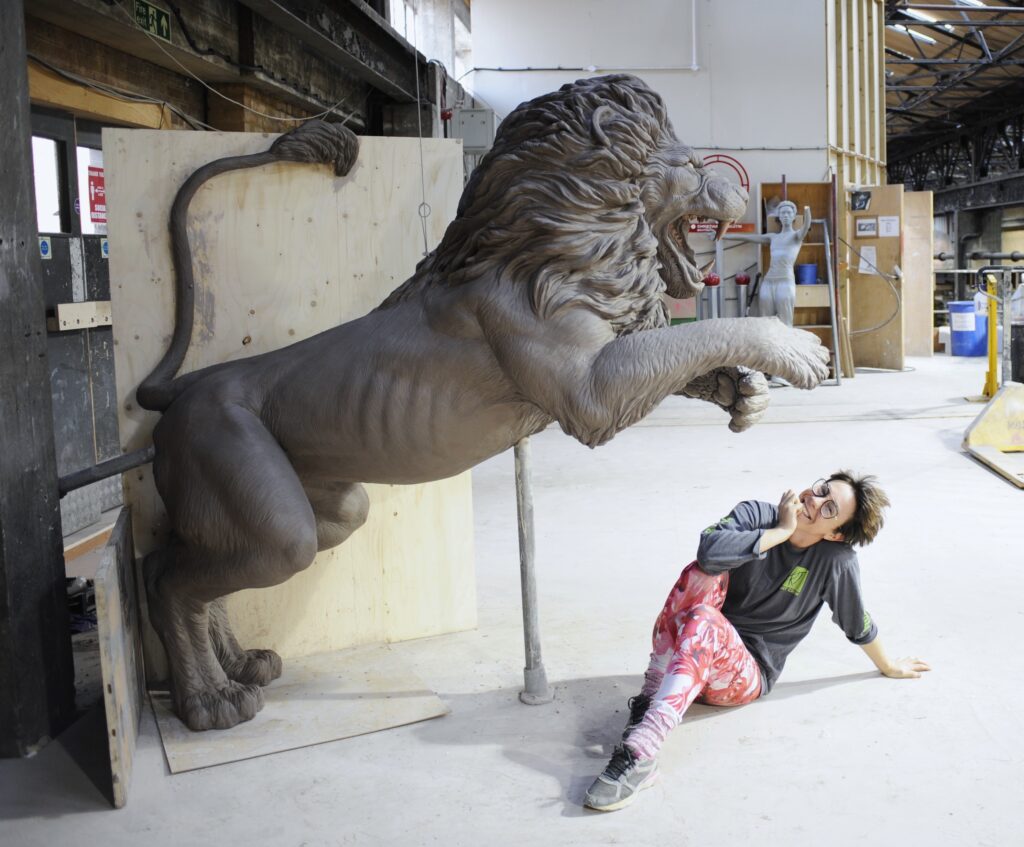
Bow Arts hears from sculptor, prop maker, and all-round creative maker Sophia Daly Rossin about new technologies, space to sculpt, and the influence of mythology on her work.

Introduce yourself and tell us a little about your practice?
Hello, I’m Sophia. I’m an Italian/Scottish sculptor from Bristol, and I’ve been living in London for the past 10 years. I work in the film industry, bespoke and commercial art fabrication. I freelance as a sculptor, prop maker, and all-round creative maker.
My post-college education was mostly hands-on and traditional. I spent three years in Venice and then five years in Barcelona, studying and working with well-known artists. I discovered that I enjoyed assembling existing objects and working with moulding and casting more than classical sculpting.
To the horror of my boss and mentor, when asked to make a two-headed chicken, I chose to go to the butcher’s and mould one rather than sculpt it. This led to a series of pieces featuring dismembered chicken heads in crockery, fighting amongst themselves, which became part of my first solo show at N2 Gallery. I spent the next few years in Barcelona as a full-time artist. Another series I created was called “Royally Golden.” It featured a dozen odd, round bird-like creatures that looked both religious and profane. They were decorated with feathers and jewels and placed on embroidered cushions and pedestals. The creatures were covered in stretched dried chicken skin, allowing a gold-plated surface to shine through.



What are you working on at the moment?
I’m working on a series with mythological, surreal-looking creatures, composed of a collage of multiple casts from the organic world, like plants, fruits, horns, dead animal parts, and their organs. This also includes human body parts like thumbs, lips, and genitalia.
There’s a strong emphasis on preserving and capturing their natural textures and patterns. This interest has created some technical challenges, leading me to invest in and learn how to use 3D scanning and printing technologies. And now this process has become intrinsically part of the work itself.
Moving from the analogue to the digital I can now play with their natural scale, tweaking and manipulating them, something I could not do before when they were cast. This ability to alter feels akin to the developing capabilities of genetic engineering and enhancement, I am considering the title of the series to be ‘Playing God’.
My intention is to turn them into lighting pieces by incorporating glass-lit elements. Although for some, this may seem like a step away from art towards function, it highlights aspects of my narrative and identity and challenges the view that art cannot be utilitarian.
I have begun to see these creations as anthropomorphised pets with their own personalities and quirks, playing a subservient role to their dominant owners. They provide us with a useful service, lighting the way while showcasing their beauty and plumage. Their desire to be seen and the act of illuminating or shining light can also be seen as a metaphor. This relationship dynamic mirrors what I see in the real world, where humans often treat nature and its inhabitants as inferior, exploiting it to suit their needs.
Incorporating these glass-lit elements with these specimen-assembled creatures speaks to my dual identity and links these mediums and influences together. My mother lives in Murano, the island of Venice famous for its glass, and I wanted to integrate this material into my work, inspired by its craftsmanship and beauty. My Scottish roots, with my earlier foray into taxidermy, and specimen preservation, an area of significant contributions from Scottish naturalists.
How do you personally experience the connection between the mind, body, and spirit in your art and overall expression?
The process of building my three-dimensional collage creatures is very different from my job, where I follow a very specific brief and the outcome is predetermined, However, in my art, not knowing where the piece will lead means nothing is ‘wrong’ or ‘right.’ I navigate by feeling and intuition, judging whether something is aesthetically pleasing to my eye, which feels very different from my structured professional tasks.
Simply being in a state of flow without over-analyzing, like automatic drawing, is when I create my best work. Reflecting on it in hindsight, with distance, it is easier to gain more insight and clarity. The surrealists considered collage a means to enact the “poetic activity of the unconscious mind,” and I can relate to this. I was once shy about my process, feeling the pressure to produce highbrow theoretical content to justify my work.
I incorporate the human body, often genitalia but not in a ‘sexy’ way—in fact, the opposite, they sit alongside elements of death and decay. Influenced by my time in the adult entertainment industry with its hyper-sexualized environment, it has given me a lot of material both literal and figurative to work with.


What’s the drive/motivation behind your work?
This is a difficult question to answer, partly therapeutic and partly a desire to communicate and entertain. I get satisfaction from combining conflicting elements, beautiful yet grotesque, light and dark, humorous and whimsical but sober and sincere. I think this creates intrigue and dialogue and another lens in which to view ourselves and our biases. I often feel as though I am continually absorbing the world around me, then regurgitating and spitting out, these accumulated feelings and overload of information. Being able to offload and turn these intangible feelings into something physical provides a meaningful outlet for my restless hands. As someone with dyslexia, traditional forms of communication often leave me feeling trapped and restricted. However, through the physical act of creating, I find liberation, self-expression, and catharsis.
What themes are you interested in?
The themes that interest me are surrealism, dystopian narratives, fables, and myth. The allure of mythology lies in its reservoir of wisdom and ancient knowledge, shaped into compelling stories. These narratives encapsulate beliefs, values, and lessons passed down through generations, that feel relevant to today.
Other themes are sexualization and power dynamics, along with taboos and the profane, but I like to present them in a way that’s entertaining, uncanny, and satirical. I find it interesting to examine difficult topics through a lens of humour, as it serves as a valuable tool for exploring and thinking about complex subjects.
I’m also interested in the interplay between the beautiful and the grotesque, particularly intertwined with death and decay. I am drawn to the transient nature of life, especially when working with fragile organic materials that are ephemeral and prone to decomposition. This creates a compelling juxtaposition with the digital world and the technologies I use to preserve them, which have a sense of permanence.

Living amid rapid AI and technological development, these themes have begun to influence my work. It’s impossible to ignore the changes happening around us. Just as the Industrial Revolution had a profound impact on artists of that era, I believe technology will inevitably influence the artists of today.
Who are your artistic influences/inspirations?
I grew up with Grimm’s fairy tales, René Magritte and The Surrealists, Frida Kahlo, Banksy, and natural history museums. Inspired by Bosch’s “Garden of Earthly Delights,” photographers like Joel-Peter Witkin, Weston, Helmut Newton, and writers like Orwell.
Other later influences included Gaudi, Historical Religious paintings, Maurizio Cattelan, the Chapman Brothers, Ron Mueck, Polly Morgan, Kate MccGwire, David Shrigley, Lucas, and Whiteread, Land art installations, and Henrique Oliveira. The “Codex Seraphinianus,” and writers like Margaret Atwood and Yuval Harari, the list goes on.
Currently, the art that I find most interesting is less based on aesthetics and use of medium and more on their underlying narratives, often political and conveying stories of struggles. I’ve just come back from the Venice Biennale, and the CATPC works in the Holland Pavilion were very powerful. Manuel Al Dowayan’s installation at the Saudi pavilion, the sculpture by Bárbara Sánchez-Kane, installations by Bouchra Khalili and Sook-Kyung Lee, and the beautiful paintings of Rember Yahuarcani, to name a few.
How has having an affordable studio impacted your practice/what is it you like about having your studio?
I am extremely grateful, to have an affordable studio space in London, as a sculptor and maker it is very difficult to find places that can cater to my needs. Proper ventilation, insulation, and natural light are aspects often overlooked as sculptors pose challenges with their need to make, noise, dust, and smell and the difficulty with stairs and lugging heavy things up and down them, it’s not a practice you can do from your spare bedroom.
Being in my studio, time slows down. I switch off, retreat from the world, and recharge. This distance gives me clarity and a fresh perspective, allowing me to resolve everyday challenges, experiment, and create. Dedicating time and energy to observe, capture, and create everyday organic shapes, forms, and textures gives me a newfound appreciation for their natural world and its beauty and complexity.
What are the challenges you face as an artist/designer/maker?
Hahaha, where to begin! After relocating from Barcelona to London, I spent a couple of years trying to survive, get into the art market, and find gallery representation, but it seemed impossible to get my foot in the proverbial door without the right connections or education.
So I took a long break from making art and being able to call myself an artist, also having to deal with some personal challenges, I decided to shelve it and focus on being a maker and getting paid to help others with their projects. In short, London is expensive, and finding a strategy that affords you the time and money to support your creativity is the main challenge I face.

Being an artist requires thick skin, self-belief, and grit. If you are your own worst critic, like I am, you can easily find yourself in a negative catch-22. It took the pandemic, for me to fully accept that I will continue creating regardless of the circumstances or outcome. Even if the work never leaves the studio or what others think, time is finite, so I might as well get on, enjoying what I love doing and ignore the rest.
The art I am drawn to making is not the most business-savvy; the process is long, time-consuming, and expensive. Each object I discover has its own bizarre story and escapade—things just take time to source and come together. An example, in Spain, there is a meat cut sold as offal that doesn’t exist in the UK. It’s the skin of the nose and mouth of a cow, which, as you can imagine, makes for some very odd hand luggage and Customs questions!
Staying focused can also be a challenge, I easily get led down rabbit holes. My work often requires or leads me to wanting to learn new skills, rather than just outsource them. I’ve taken up taxidermy, iconography, scaffolding, electroforming and plating, gilding, prosthetics, 3D printing, and several software programs. I’m not tech-savvy and a slow learner, but that hasn’t stopped me from banging my head against a wall in pursuit of problem-solving and wanting to understand.
Maybe being an artist is more about the journey than the end product, at least in my case—or
maybe that’s just an excuse!
Where can we find your work?
My website www.dalyrossin.com.
Bio
Sophia grew up in a creative household in Bristol, a pupil of the alternative Waldorf Steiner school. Her Italian mother, a lover of classical and modern art, was a stained-glass artist and Dance teacher. Her Scottish father was a structural engineer with an eye for function and design.
On completing her Art and Design College education in Bristol, she journeyed to Venice, immersing herself in the world of classical painting and drawing through her studies at the Liceo for two years. During this time, she worked for Gianfranco Meggiato, a notable Italian bronze artist, learning to sculpt in wax and the process of bronze casting.
With a growing interest in 3D forms and contemporary art, she enrolled in an international arts program located in Barcelona, Spain. It was there that she settled for several years, establishing her own art studio and dedicating herself to being a full-time practising artist. Continuing to improve her knowledge of sculpting through her work for the esteemed Catalan sculptor, Samuel Salcedo.
Now based in London for the last ten years, She divides her time between her art practice and her contracting freelance business, SDR Creates. Built up through her experience of working in the industry over the decade, It specialises in Sculpture, Prop Making Fabrication and Creatures.